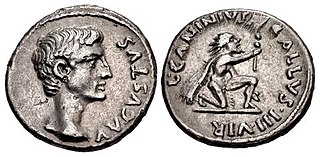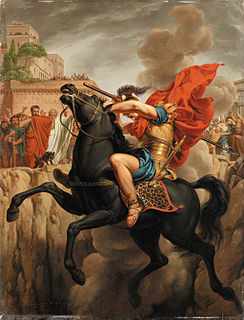Related Research Articles
The gens Aelia, occasionally written Ailia, was a plebeian family in Rome, which flourished from the fifth century BC until at least the third century AD, a period of nearly eight hundred years. The archaic spelling Ailia is found on coins, but must not be confused with Allia, which is a distinct gens. The first member of the family to obtain the consulship was Publius Aelius Paetus in 337 BC.
The gens Caesetia was a minor plebeian family at ancient Rome. It is known from a small number of individuals living during the late Republic.

The gens Hostilia was an ancient family at Rome, which traced its origin to the time of Romulus. The most famous member of the gens was Tullus Hostilius, the third King of Rome; however, all of the Hostilii known from the time of the Republic were plebeians. Several of the Hostilii were distinguished during the Punic Wars. The first of the family to obtain the consulship was Aulus Hostilius Mancinus in 170 BC.

The gens Caninia was a plebeian family at ancient Rome during the later Republic. The first member of the gens who obtained any of the curule offices was Gaius Caninius Rebilus, praetor in 171 BC; but the first Caninius who was consul was his namesake, Gaius Caninius Rebilus, in 45 BC.
The gens Sextilia was a plebeian family at ancient Rome. The first member of this gens to achieve prominence was Gaius Sextilius, consular tribune in 379 BC. None of the family obtained the consulship, but they endured throughout Roman history from the early Republic into imperial times.
The gens Cispia was a plebeian family at Rome. Although the gens was supposedly of great antiquity, the Cispii only achieved prominence toward the end of the Republic.
The gens Coponia was a plebeian family at Rome. The family was prominent at Rome during the first century BC. The most famous of the gens may have been Gaius Coponius, praetor in 49 BC, and a partisan of Pompeius, whom although proscribed by the triumvirs in 43, was subsequently pardoned, and came to be regarded as a greatly respected member of the Senate.
The gens Cosconia was a plebeian family at Rome. Members of this gens are first mentioned in the Second Punic War, but none ever obtained the honours of the consulship; the first who held a curule office was Marcus Cosconius, praetor in 135 BC.
The gens Curia was a plebeian family at ancient Rome. Members of this gens are first mentioned at the beginning of the third century BC, when the family was rendered illustrious by Manius Curius Dentatus.

The gens Curtia was an ancient but minor noble family at Rome, with both patrician and plebeian branches. The only member of the gens invested with the consulship under the Republic was Gaius Curtius Philo, in 445 BC. A few Curtii held lesser magistracies during the Republic, and there were two consuls suffectus in imperial times. However, the gens is best remembered from a series of legends dating from the traditional founding of the city to the early Republic.
The gens Egnatia was a plebeian family of equestrian rank at ancient Rome. Only a few of the Egnatii held any magistracies, of whom the most important may have been Gnaeus Egnatius, who held the praetorship during the second century BC, and served as governor of Macedonia, shortly after its institution as a Roman province.
The gens Epidia was an obscure plebeian family at ancient Rome. The only members to achieve any importance lived during the first century BC.
The gens Flaminia was a plebeian family at ancient Rome. During the first five centuries of Rome, no mention is made of any member of the Flaminia gens. In former times the Flaminii were believed to be only a family of the Quinctia gens; but this opinion arose from a confusion of the Flaminii with the Flaminini, the latter of whom belonged to the ancient patrician Quinctia gens.

The gens Fonteia was a plebeian family at ancient Rome. Members of this gens are first mentioned toward the end of the third century BC; Titus Fonteius was a legate of Publius Cornelius Scipio during the Second Punic War. The first of the Fonteii to obtain the consulship was Gaius Fonteius Capito, consul suffectus in 33 BC.
The gens Fufia was a plebeian family at ancient Rome. The gens does not appear to have been of great antiquity, and only appears in history toward the beginning of the first century BC.

The gens Fundania was a plebeian family at Ancient Rome, which first appears in history in the second half of the third century BC. Although members of this gens occur well into imperial times, and Gaius Fundanius Fundulus obtained the consulship in BC 243, the Fundanii were never amongst the more important families of the Roman state.
The gens Gallia was a plebeian family at ancient Rome. Several members of this gens are mentioned during the first century BC.
Marcus Gratidius was a Roman statesman and orator from Arpinum during the late second century BC. He is best known as a result of his connections with Cicero and Marius.
The gens Gratidia was a plebeian family at ancient Rome. Originally coming from Arpinum, members of this gens are known from the final century of the Republic.
The gens Hirria was a minor Roman family, appearing in history during the final century of the Republic, and in Imperial times. It is chiefly remembered as the result of Gaius Hirrius, a farmer of lampreys in the time of Caesar.
References
![]() This article incorporates text from a publication now in the public domain : Smith, William, ed. (1870). Dictionary of Greek and Roman Biography and Mythology .Missing or empty
This article incorporates text from a publication now in the public domain : Smith, William, ed. (1870). Dictionary of Greek and Roman Biography and Mythology .Missing or empty |title= (help)
- 1 2 3 Dictionary of Greek and Roman Biography and Mythology , William Smith, Editor.
- ↑ Marcus Tullius Cicero, Epistulae ad Familiares, xvi. 27.
- ↑ Marcus Vitruvius Pollio, Praef., vii.
- ↑ Titus Livius, Ab Urbe Condita , xli. 20.
- ↑ Marcus Velleius Paterculus, Compendium of Roman History, i. 10.
- ↑ Athenaeus, Deipnosophistae , v. p. 594, a.
- ↑ Strabo, Geographica , ix. p. 396.
- ↑ Gaius Plinius Secundus, Historia Naturalis , xxxvi. 5.
- ↑ Marcus Tullius Cicero, In Verrem , iii. 22, 80.
- ↑ Gaius Suetonius Tranquillus, De Vita Caesarum , Caesar, 1.
- ↑ Sear, David R. (1998). The History and Coinage of the Roman Imperators 49-27 BC. Spink. p. 76. ISBN 9780907605980.